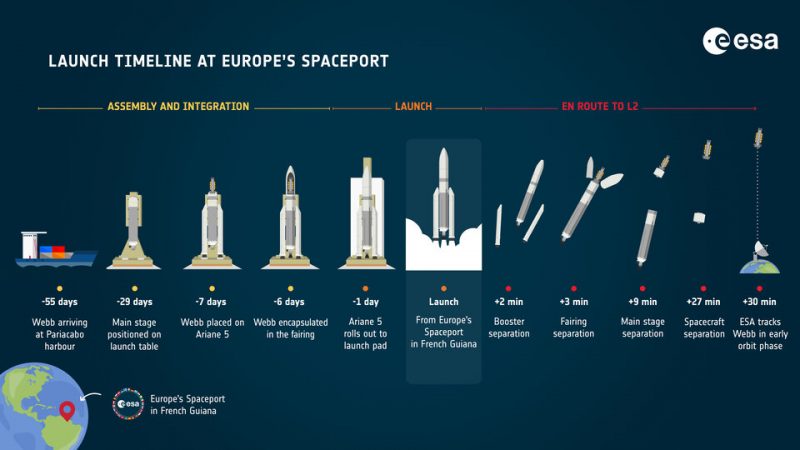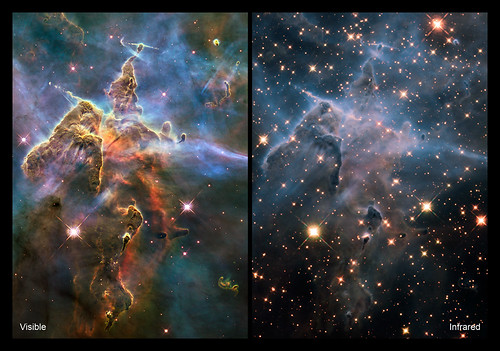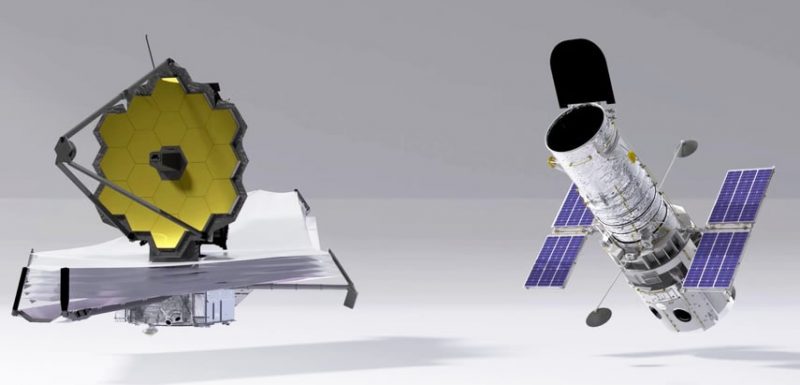
James Webb Telescope launch delayed again
UPDATE NOVEMBER 22, 2021. A NASA statement today said that the launch date for the James Webb Space Telescope has been pushed back again. The launch had been scheduled for December 18, 2021. NASA said the launch now will occur no earlier than December 22. The statement in its entirety follows:
The launch readiness date for the James Webb Space Telescope is moving to no earlier than December 22 to allow for additional testing of the observatory, following a recent incident that occurred during Webb’s launch preparations.
The incident occurred during operations at the satellite preparation facility in Kourou, French Guiana, performed under Arianespace overall responsibility. Technicians were preparing to attach Webb to the launch vehicle adapter, which is used to integrate the observatory with the upper stage of the Ariane 5 rocket. A sudden, unplanned release of a clamp band – which secures Webb to the launch vehicle adapter – caused a vibration throughout the observatory.
A NASA-led anomaly review board was immediately convened to investigate and instituted additional testing to determine with certainty the incident did not damage any components. NASA and its mission partners will provide an update when the testing is completed at the end of this week.
Webb was previously scheduled to launch December 18 on an Arianespace Ariane 5 rocket from Kourou.
ORIGINAL STORY – DATED OCTOBER 12, 2021 – BEGINS BELOW:

Webb Telescope nears launch
The European Space Agency (ESA) said on October 12, 2021, that the James Webb Space Telescope – Hubble’s successor – has arrived safely at Pariacabo harbor in French Guiana. At this point, the launch date is holding steady at December 18. Exciting!
ESA said it’s now working in close collaboration with NASA to prepare what it called a once-in-a-generation mission for the Webb’s launch on an Ariane 5 rocket from Europe’s Spaceport in French Guiana. Launch processing teams need to prepare and configure the Webb for flight. This involves post-shipment checkouts and carefully loading the spacecraft’s propellant tanks with fuel. Then, engineering teams will mate the Webb to its launch vehicle, an Ariane 5 rocket provided by ESA, and do a “dress rehearsal” before it rolls out to the launch pad two days before launch. ESA said:
Few space science missions have been as eagerly anticipated as the James Webb Space Telescope (Webb). As the next great space science observatory following Hubble, Webb is designed to resolve unanswered questions about the universe and see farther into our origins: from the formation of stars and planets to the birth of the first galaxies in the early universe.
Every launch requires meticulous planning and preparation. For Webb, this process began about 15 years ago. Its arrival at Pariacabo harbor is a major milestone in the Ariane 5 launch campaign.
Webb arrived from California on board the MN Colibri which sailed the Panama Canal to French Guiana. The shallow Kourou River was specially dredged to ensure a clear passage and the vessel followed high tide to safely reach port.
The space telescope recently underwent testing at Northrop Grumman’s facilities in California. Following launch, the massive space observatory will make its way to Lagrange Point 2, or L2, a gravitationally stable point 930,000 miles (1.5 million km) from our planet.

Video of simulation of the Webb’s launch and deployment, from the Space Telescope Science Institute.
Launch from near Earth’s equator
In summer 2021, NASA had announced that the telescope would ship to the launch site in August “with little to no schedule margin.” That tight schedule would bring the telescope to launch readiness no earlier than October 31. The new launch date of December 18, 2021, was announced in September.
Following launch, Webb will take about a month to fly to the L2 point in space. As it travels there, beginning a few days after launch it’ll start to slowly unfold its biggest feature, its tennis court-sized sunshield. The sunshield is designed to reduce the sun’s heat by more than a million times to -364 degrees F (-220 degrees C). Webb’s mirror and instrumentation have to be kept cold. If they were to be heated up by the sun, they’d give off infrared radiation. And it’s faint infrared signals from the distant cosmos that the Webb is meant to measure. ESA commented that each step of the cool-down process:
… can be controlled expertly from the ground, giving Webb’s launch full control to circumnavigate any unforeseen issues with deployment.
ESA said the mission team can manage the cool-down, which will take several weeks, with heaters to control stresses on instruments and structures. In the meantime, ESA said:
… the secondary mirror tripod will unfold, the primary mirror will unfold, Webb’s instruments will slowly power up, and thruster firings will insert the observatory into a prescribed orbit.
After orbital insertion, and after the telescope has cooled down and stabilized at its frigid operating temperature, the mission team will spend several months aligning its optics and calibrating its scientific instruments. Then Webb will begin studying the cosmos in infrared light using its dazzling golden mirror.

What’s huge, grand, and golden?
One of the Webb’s most important and identifiable attributes is its 21-foot-wide (6.5-meter-wide) primary mirror. A reflecting telescope’s primary mirror determines how much light it can collect, and thus how deeply it can see into the universe. Webb’s mirror is nearly three times wider than Hubble’s primary mirror.
You might hear people speak of the Webb’s golden mirror. The mirror is actually multiple mirrors. It’s composed of 18 separate hexagonal-shaped segments made of very strong, ultra-lightweight beryllium, which will unfold after launch. Each of the telescope’s mirror segments is covered in a microscopically thin layer of gold. This gold covering optimizes the mirror segments for reflecting infrared light, which is the primary wavelength of light this telescope will observe.
Webb Telescope has had a long road
The Webb’s development began in 1996, with a $500 million budget. Space scientists and engineers initially planned the launch for 2007. But the project has had considerable delays and cost overruns, and it underwent a major redesign in 2005. Afterward, they planned the launch for March 2020, but the coronavirus pandemic struck and caused major setbacks.
Yet, now, the team has made significant progress. NASA says existing program funding will have the Webb finished within its current $8.8 billion cost cap. In December 2020, the sunshield of a fully assembled James Webb Space Telescope successfully completed its own final tests, including a complete unfolding, just as the telescope will need to do once in space.
Formerly known as the Next Generation Space Telescope, scientists renamed the Webb in September 2002 after James Webb, who was an esteemed former NASA administrator.
NASA, the European Space Agency, and the Canadian Space Agency are partnering on the Webb. NASA’s Goddard Space Flight Center in Greenbelt, Maryland, manages the development effort, while Northrop Grumman serves as the project’s main industrial partner.
As it has for the Hubble Space Telescope, the Space Telescope Science Institute in Baltimore will be operating the Webb telescope after launch.

Technologies advance
As you would expect, the capabilities of the Webb extend beyond those of the Hubble Space Telescope. NASA likes to say that the Webb is not a replacement for Hubble, but rather a successor. The two telescopes will collaborate side by side for a while, with a planned overlap.
The Webb will observe farther into the infrared regions of the electromagnetic spectrum than Hubble. It’ll go even deeper into space than Hubble, and thus it’ll look farther into the past. It’ll be able to peer inside stellar dust clouds where stars and star systems form. Thaddeus Cesari, a communications specialist for the mission, wrote:
In addition to the groundbreaking science expected from it after launch, Webb has required an improvement in the testing infrastructure and processes involved in validating large complex spacecraft for a life in space … Lessons learned from previous space telescope development were invested into Webb, and future space telescopes will be built upon the same collective knowledge.
Thousands of scientists, engineers, and technicians contributed to build, test, and integrate Webb. In total, 258 companies, agencies, and universities participated: 142 from the United States, 104 from 12 European nations, and 12 from Canada.


Bottom line: The James Webb Space Telescope is the world’s most complex infrared telescope. The telescope has now arrived in French Guiana, where it’ll launch on an Ariane 5 rocket from Europe’s Spaceport on December 18, 2021.
The post James Webb Telescope – Hubble’s successor – launch delayed again first appeared on EarthSky.
0 Commentaires